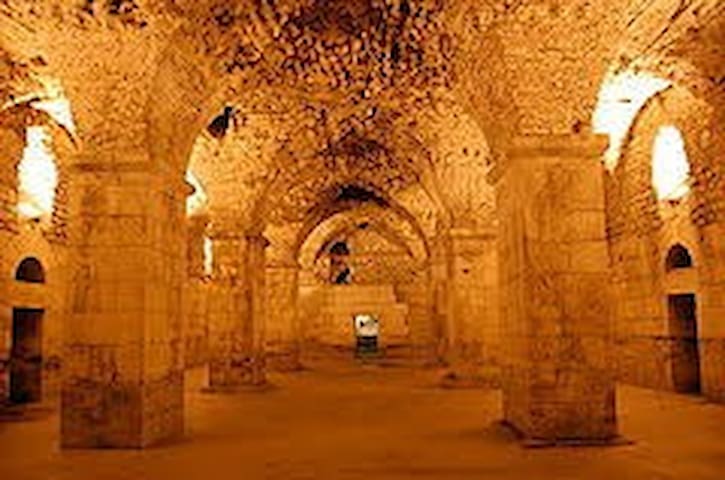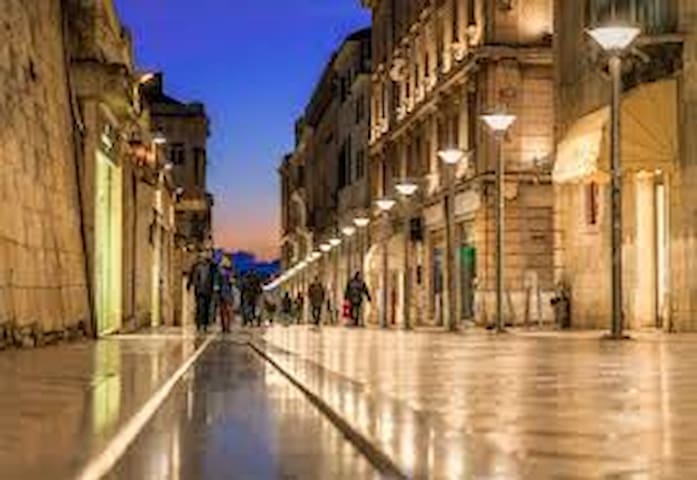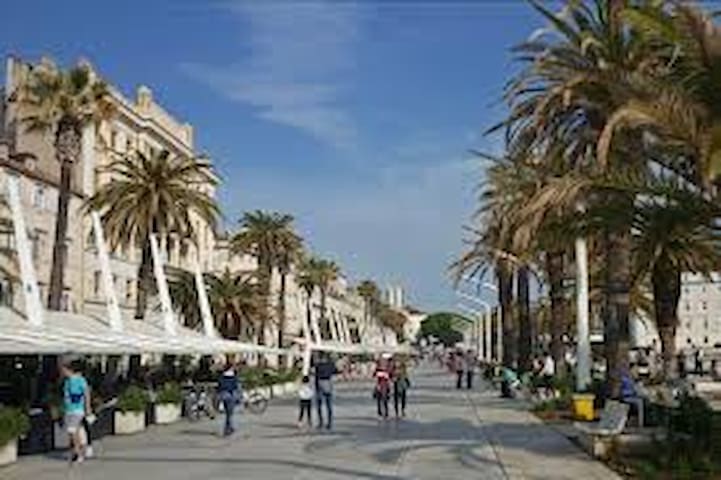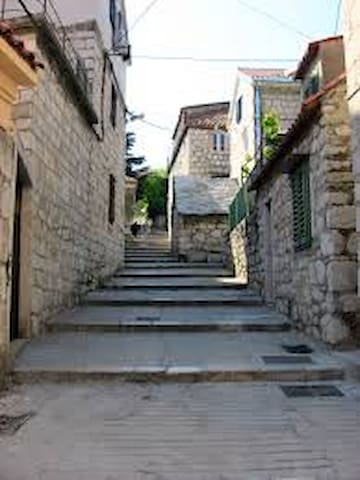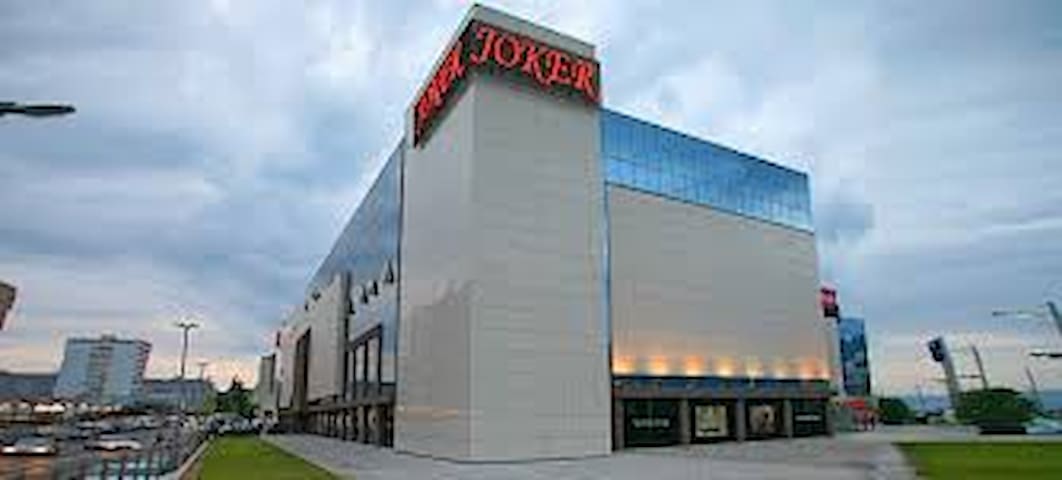Razgledavanje
Attractions in Split: Diocletian's Palace, ...
Diocletian's Palace is among the best preserved monuments of the Roman building heritage in the world. Owing to the research done during 20th century by an Austrian G. Niemann and by a French E. Herbrard, based on the previous research done by an Englishman R. Adam in 18th century, the original layout of the Palace has been disclosed. More systematic research and study of the Palace have been conducted since 1950s.
2289 Recomendado por los habitantes de la zona
Recorrido a pie por el Palacio de Diocleciano
1 Dioklecijanova ul.Attractions in Split: Diocletian's Palace, ...
Diocletian's Palace is among the best preserved monuments of the Roman building heritage in the world. Owing to the research done during 20th century by an Austrian G. Niemann and by a French E. Herbrard, based on the previous research done by an Englishman R. Adam in 18th century, the original layout of the Palace has been disclosed. More systematic research and study of the Palace have been conducted since 1950s.
Prokurative or as they are officially called, Republic Square resemble the Venice St. Marks Square. They are located west of the Riva and they were named after the arches found on the neo-Renaissance buildings surrounding the square on three sides. Most people to this day know it by that name. The square is only open on the south side, providing a beautiful view of the harbour and the Riva (waterfront). The building of the Prokurativa was initiated by one of the most renowned mayors in the history of the city Antonio Bajamonti in the mid 19th century. He wanted to show that Split supported Italian tradition with all its might. Hence the colonnade resembling Venetians, and reliefs above the windows evoking the ancient and Renaissance influences. Bajamonti also made his great theatre on the square, but it was destroyed by a fire.
The square has long been established as an excellent stage for cultural events, especially the pop music festival, and the local bars and restaurants made it a popular venue for the citizens of Split. The plateau on the south side has always been an integral part of Prokurative, with, ever since 1947, a neo-Classical fountain, destroyed by the communist authorities, due to its alleged connection to the Italian rule over Split and Dalmatia.
66 Recomendado por los habitantes de la zona
Trg Republike
Prokurative or as they are officially called, Republic Square resemble the Venice St. Marks Square. They are located west of the Riva and they were named after the arches found on the neo-Renaissance buildings surrounding the square on three sides. Most people to this day know it by that name. The square is only open on the south side, providing a beautiful view of the harbour and the Riva (waterfront). The building of the Prokurativa was initiated by one of the most renowned mayors in the history of the city Antonio Bajamonti in the mid 19th century. He wanted to show that Split supported Italian tradition with all its might. Hence the colonnade resembling Venetians, and reliefs above the windows evoking the ancient and Renaissance influences. Bajamonti also made his great theatre on the square, but it was destroyed by a fire.
The square has long been established as an excellent stage for cultural events, especially the pop music festival, and the local bars and restaurants made it a popular venue for the citizens of Split. The plateau on the south side has always been an integral part of Prokurative, with, ever since 1947, a neo-Classical fountain, destroyed by the communist authorities, due to its alleged connection to the Italian rule over Split and Dalmatia.
Although a conqueror, Napoleon's marshal Marmont is responsible for the urbanisation of Dalmatian cities, in return the citizens of Split have named their most beautiful street after him. Marmont street is not only beautiful but also historically meaningful. In 1922 a library and a reading room has been founded there for Francophiles, today Alliance Francaise. The first cinema of Split found its home there as well. A unique fish market decorates its centre, special because of the fact that you won't find flies there due to the smell of sulphur which can still be felt from the neighbouring spa. It is also decorated by the beautiful Secession buildings Duplančić and Tončić, while its northern end boarders through Venetian bastion with the architecture of the Theatre and the church of Our Lady of Good Health. Two of the most popular exhibition centres in the city are also in this street, Salon Galić and the Photo Gallery. A couple of passage ways lead directly from it to Prokurative. From the Riva to the top of Marmont street numerous shops line up from right to left, turning this street into one of the most important shopping oases' of the city centre, while the top of the street is thrusting with popular cafés and restaurants. Witty contemporary fountain, called Pirja, should not be missed! It still makes you wonder what was the message the artist was trying to convey?
284 Recomendado por los habitantes de la zona
Marmontova ulica
6-8 Marmontova ul.Although a conqueror, Napoleon's marshal Marmont is responsible for the urbanisation of Dalmatian cities, in return the citizens of Split have named their most beautiful street after him. Marmont street is not only beautiful but also historically meaningful. In 1922 a library and a reading room has been founded there for Francophiles, today Alliance Francaise. The first cinema of Split found its home there as well. A unique fish market decorates its centre, special because of the fact that you won't find flies there due to the smell of sulphur which can still be felt from the neighbouring spa. It is also decorated by the beautiful Secession buildings Duplančić and Tončić, while its northern end boarders through Venetian bastion with the architecture of the Theatre and the church of Our Lady of Good Health. Two of the most popular exhibition centres in the city are also in this street, Salon Galić and the Photo Gallery. A couple of passage ways lead directly from it to Prokurative. From the Riva to the top of Marmont street numerous shops line up from right to left, turning this street into one of the most important shopping oases' of the city centre, while the top of the street is thrusting with popular cafés and restaurants. Witty contemporary fountain, called Pirja, should not be missed! It still makes you wonder what was the message the artist was trying to convey?
Gastronomska scena
Pjaca (People's Square, another square nobody in Split calls by its real name), is first mentioned in 13th century as St Lawrence's Square, and it was the first inhabited part of Split outside the Diocletian Palace, leaning to its western wall. Already for centuries the Pjaca is the central stage of the city life, there in the Gothic building of the Old Town Hall, today an exhibition centre, was the seat of the city's authority, and in still beautiful and preserved Palaces on the outskirts of the Pjaca lived the noble families Cambi, Pavlović, Nakić, Ciprianis, Karepić... Still open is one of the oldest book shops in the world, Morpurgo, to this day it looks almost the same as it looked in 1861, and in the Café Central where the intellectuals of Split gathered is where the tourism of Split begun with the former hotel Troccoli.
The city clock has been ticking for centuries on Pjaca, unique by his 24 instead of 12 digits, and in the surrounding cafés, restaurants and bars the citizens of Split could always find a place to rest, meet, be seen and see others, go through the most important events of the city. Every building on Pjaca has its story, each is a witness of history and the spirit of the city. As it was yesterday, it is also today, when Pjaca is filled with numerous bars, restaurants and shops, and when it became one of the most important spots for tourists wishing to enjoy in whatever it is that their hosts, citizens of Split, are enjoying.
39 Recomendado por los habitantes de la zona
People's Square or Pjaca
Narodni trgPjaca (People's Square, another square nobody in Split calls by its real name), is first mentioned in 13th century as St Lawrence's Square, and it was the first inhabited part of Split outside the Diocletian Palace, leaning to its western wall. Already for centuries the Pjaca is the central stage of the city life, there in the Gothic building of the Old Town Hall, today an exhibition centre, was the seat of the city's authority, and in still beautiful and preserved Palaces on the outskirts of the Pjaca lived the noble families Cambi, Pavlović, Nakić, Ciprianis, Karepić... Still open is one of the oldest book shops in the world, Morpurgo, to this day it looks almost the same as it looked in 1861, and in the Café Central where the intellectuals of Split gathered is where the tourism of Split begun with the former hotel Troccoli.
The city clock has been ticking for centuries on Pjaca, unique by his 24 instead of 12 digits, and in the surrounding cafés, restaurants and bars the citizens of Split could always find a place to rest, meet, be seen and see others, go through the most important events of the city. Every building on Pjaca has its story, each is a witness of history and the spirit of the city. As it was yesterday, it is also today, when Pjaca is filled with numerous bars, restaurants and shops, and when it became one of the most important spots for tourists wishing to enjoy in whatever it is that their hosts, citizens of Split, are enjoying.
The Riva started to look the way it does today two centuries ago, when the French, in time of Napoleon ruled these parts through Marshal Marmont. Today this promenade is the cities living room, the most popular and most important public place in Split. In the meantime it has been widened and reconstructed several times, but it was always blessed with the most spectacular set, the south facade of the Diocletian Palace, with the entrance into the Substructures, and later on with the buildings that were built west of the Palace, also the Franciscan monastery with the church of St. Francis, and the Bajamonti Dešković Palace and last but not least the Port Authorities building on the east end.
Riva today is a pedestrian heaven, thrusting with Cafés and restaurants, an ideal place for having your morning or afternoon coffee, or for an evening out with friends over drinks. Riva is the stage of the city life of Split, a venue for numerous cultural and entertainment events, boisterous Split carnival, as well as the stage for meeting Split sportsmen after countless successes, such as Goran Ivanišević, Hajduk football club players and Jugoplastika basketball players, Olimpic medal winners... Riva is also a political forum, with decades of political opportunities being depicted through mass rallies. Naturally, Riva is always at its best in time of Sudamja, a celebration dedicated to St. Domnius, the patron saint of Split.
791 Recomendado por los habitantes de la zona
Riva
The Riva started to look the way it does today two centuries ago, when the French, in time of Napoleon ruled these parts through Marshal Marmont. Today this promenade is the cities living room, the most popular and most important public place in Split. In the meantime it has been widened and reconstructed several times, but it was always blessed with the most spectacular set, the south facade of the Diocletian Palace, with the entrance into the Substructures, and later on with the buildings that were built west of the Palace, also the Franciscan monastery with the church of St. Francis, and the Bajamonti Dešković Palace and last but not least the Port Authorities building on the east end.
Riva today is a pedestrian heaven, thrusting with Cafés and restaurants, an ideal place for having your morning or afternoon coffee, or for an evening out with friends over drinks. Riva is the stage of the city life of Split, a venue for numerous cultural and entertainment events, boisterous Split carnival, as well as the stage for meeting Split sportsmen after countless successes, such as Goran Ivanišević, Hajduk football club players and Jugoplastika basketball players, Olimpic medal winners... Riva is also a political forum, with decades of political opportunities being depicted through mass rallies. Naturally, Riva is always at its best in time of Sudamja, a celebration dedicated to St. Domnius, the patron saint of Split.
Amazing food, great service, really good prices and value for money combined with a cosy atmosphere
137 Recomendado por los habitantes de la zona
Artičok
3 Ul. bana Josipa JelačićaAmazing food, great service, really good prices and value for money combined with a cosy atmosphere
This place has amazingly friendly staff, great ambiance, a vast range of cocktails (you don't have to stick to the menu, just ask for your favourite) and great pizza.
238 Recomendado por los habitantes de la zona
Pizzeria Bokamorra
16 Trumbićeva obala This place has amazingly friendly staff, great ambiance, a vast range of cocktails (you don't have to stick to the menu, just ask for your favourite) and great pizza.
Had a beautiful meal of steak tartare and then the grilled octopus which was AMAZING!! Nice ambience and friendly staff.
661 Recomendado por los habitantes de la zona
Bokeria kitchen & wine bar
8 Domaldova ul.Had a beautiful meal of steak tartare and then the grilled octopus which was AMAZING!! Nice ambience and friendly staff.
The food is delicious and the staff are very good!
336 Recomendado por los habitantes de la zona
Chops Grill - steak&seafood
4 Tončićeva ul.The food is delicious and the staff are very good!
Gradske četvrti
Veli Varoš and Lučac keep the Split city core in a "historical sandwich", competing for the title of the oldest suburbs. Citizens of Lučac boast with the ancient Illyrian toponym Radunice, while the citizens of Veli Varoš stress their ancientness climbing the Marjan hill above.
Veli Varoš abounds with well preserved local architecture and original local ambient. Walking uphill in Veli Varoš should be repeated couple of times in order to perceive the remainder of the games stones play up the steep streets and in order to catch all the details while looking over the rooftops from the Prva Vidilica (First Peak).
Among the best known architectural monuments the most famous is the Church of St. Mikula from the 11th century, on the lintel above the facade, next to the images of lionesses is the name of the citizen Ivan and his wife Tiha.
Let us mention once again also the churches that adorn Veli Varoš, church of Our Lady of Soca, the Holy Cross and St. Francis. Veli Varoš has been, until recently, the symbol of fishermen from Split who lived poorly of their daily sardines (Spli'ski akvarel, musical by Ivo Tijardović), while today real-estate prices in this part of the city have gone through the roof.
Many famous opera singers came from Veli Varoš, like Noa Matošić, Ante Marušić and Ratomir Kliškić, as well as Miljenko Smoje, the famous journalist and publicist.
34 Recomendado por los habitantes de la zona
Varoš
Veli Varoš and Lučac keep the Split city core in a "historical sandwich", competing for the title of the oldest suburbs. Citizens of Lučac boast with the ancient Illyrian toponym Radunice, while the citizens of Veli Varoš stress their ancientness climbing the Marjan hill above.
Veli Varoš abounds with well preserved local architecture and original local ambient. Walking uphill in Veli Varoš should be repeated couple of times in order to perceive the remainder of the games stones play up the steep streets and in order to catch all the details while looking over the rooftops from the Prva Vidilica (First Peak).
Among the best known architectural monuments the most famous is the Church of St. Mikula from the 11th century, on the lintel above the facade, next to the images of lionesses is the name of the citizen Ivan and his wife Tiha.
Let us mention once again also the churches that adorn Veli Varoš, church of Our Lady of Soca, the Holy Cross and St. Francis. Veli Varoš has been, until recently, the symbol of fishermen from Split who lived poorly of their daily sardines (Spli'ski akvarel, musical by Ivo Tijardović), while today real-estate prices in this part of the city have gone through the roof.
Many famous opera singers came from Veli Varoš, like Noa Matošić, Ante Marušić and Ratomir Kliškić, as well as Miljenko Smoje, the famous journalist and publicist.
Like pazar
The Fish Market is, just like Pazar, one of the central points of the city life of Split, but also an interesting architectural monument, built over 120 years ago in Secession style. It is important to note that its meaning for the citizens of Split greatly transcends this merely "physical" dimension. All that the Adriatic sea can offer comes to its tables, from sprats, picarels, sardines, mackerels, to more expensive redscorpion fish, dentex, red porgy, sea bass, lobsters, sea shells... The only thing that's missing are flies, it seems that they don't care for the smell of sulphur coming from the neighbouring spa, one of the reasons why Diocletian, burdened by rheumatism, chose exactly this place to build his Palace. Just like on Pazar, the Fish Market, or Peškarija, as the locals call it, will make you feel the affiliation of Split and Dalmatia to the Mediterranean, its culture and civilization.
Peškarija has become too small for Split long time ago, but it is too valuable for the preservation of the city's spirit for anyone to even think of giving it up. The visitors coming to the fish market for their "portion" of Split are also very aware of this fact.
136 Recomendado por los habitantes de la zona
Fishmarket
5 Obrov ul.The Fish Market is, just like Pazar, one of the central points of the city life of Split, but also an interesting architectural monument, built over 120 years ago in Secession style. It is important to note that its meaning for the citizens of Split greatly transcends this merely "physical" dimension. All that the Adriatic sea can offer comes to its tables, from sprats, picarels, sardines, mackerels, to more expensive redscorpion fish, dentex, red porgy, sea bass, lobsters, sea shells... The only thing that's missing are flies, it seems that they don't care for the smell of sulphur coming from the neighbouring spa, one of the reasons why Diocletian, burdened by rheumatism, chose exactly this place to build his Palace. Just like on Pazar, the Fish Market, or Peškarija, as the locals call it, will make you feel the affiliation of Split and Dalmatia to the Mediterranean, its culture and civilization.
Peškarija has become too small for Split long time ago, but it is too valuable for the preservation of the city's spirit for anyone to even think of giving it up. The visitors coming to the fish market for their "portion" of Split are also very aware of this fact.
The outdoor market - Pazar, is located right next to the east wall of the Diocletian Palace, and around the church of St Dominic. It is one of the central places of life in Split, and recently its becoming also a popular destination for tourists eager to feel the local spirit. The outdoor market used to be on today's Fruit Square, but due to the rapid city development there was a need for a bigger space, and today that part of the city's core is the true belly of the city of Split. At the same time it is the place where you can still feel the spirit of Dalmatia and the Mediterranean, the colours, flavours and aromas of fresh fruits and vegetables, but also the sounds, the yelling and bargaining, all of the above will without a doubt be a clear clue to where you are at that moment. Of course all that you can buy on the open market can also be bought in any supermarket, even cheaper, but nothing can replace the local atmosphere.
201 Recomendado por los habitantes de la zona
Pazar Split
3 HrvojevaThe outdoor market - Pazar, is located right next to the east wall of the Diocletian Palace, and around the church of St Dominic. It is one of the central places of life in Split, and recently its becoming also a popular destination for tourists eager to feel the local spirit. The outdoor market used to be on today's Fruit Square, but due to the rapid city development there was a need for a bigger space, and today that part of the city's core is the true belly of the city of Split. At the same time it is the place where you can still feel the spirit of Dalmatia and the Mediterranean, the colours, flavours and aromas of fresh fruits and vegetables, but also the sounds, the yelling and bargaining, all of the above will without a doubt be a clear clue to where you are at that moment. Of course all that you can buy on the open market can also be bought in any supermarket, even cheaper, but nothing can replace the local atmosphere.
Nightlife
Best place to have the Concert in the Split City, Excellent staff, the great PARTY!
Central the Club
4 Trg Gaje BulataGood music!
Vanilla Club
21 Osmih mediteranskih igaraShopping
Joker Mall
6 Put BrodariceNear the accommodation. Enough stores.

